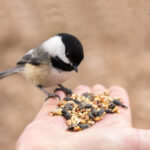Setsubun is celebrated on February 3 each year, however, it can also be celebrated a day before on February 2, or a day after on February 4 depending on the Japanese lunar calendar. The day marks the onset of spring and kicks off the spring festival in Japan, called Hina Matsuri.
History of Setsubun
Tsuina or Setsubun originated from a religion called Nuo Folk from the Tujia community in China in the 8th century. Nuo folk practices exorcism where demons are forced to leave a person using various methods. In the 13th century, these evil spirits were exorcised by burning wood, dried heads of sardines, and beating drums loudly. This practice continues in Japan today, but with roasted soybeans in a practice called ‘mamemaki,’ the beans are either thrown out the door of your home or at a family member wearing a demon’s mask while shouting “Devil out! Fortune in!” People then eat roasted soybeans, believed to bring good fortune, and where one bean represents each year of life. An additional one is enjoyed to bring good luck in the coming year. It’s also common in present-day Japan, to see dried sardine heads and holly leaves hanging outside houses, the purpose of which is to drive away demons.
In the Kansai region, people observe Setsubun by eating special sushi rolls called ‘eho-maki’ that are believed to bring good luck when eaten while facing the ‘lucky direction,’ determined by that year’s zodiac sign. For instance, the lucky direction of 2021 was South-South-East. Now, this tradition has spread to other areas of Japan as well.
Since the day celebrates a change of season, people also dress up as their ‘opposite’ where, for example, young girls dress up as older women and vice versa or where men dress up as women.
Setsubun timeline
Chinese Nuo Folk religion influences exorcism practice during Setsubun.
Japan adopts the custom of warding off evil spirits by burning dried sardine heads.
The custom of ‘mamemaki,’ or throwing soybeans is introduced.
Japan switches to the Gregorian calendar but the Chinese lunar calendar is still followed for many occasions.
Setsubun FAQs
What does the ‘Oni’ mask mean?
‘Oni’ is a kind of demon in Japanese folklore and the mask used during Setsubun festivities represents this hulking figure that has one or more horns growing from its head.
Why do oni hate soybeans?
‘Mame’ means ‘destroying evil’ which is why soybeans are thought to ward off Japanese demons known as oni. Similar to how garlic is believed to be an effective weapon against vampires in the West.
Do people drink sake on Setsubun?
Yes, while this is not the main attraction of Setsubun, many temples and shrines in Japan serve a sweet, low-alcohol sake called ‘amazake.’
Setsubun Activities
Throw beans
“Oni wa Soto! Fuku wa Uchi!” is Japanese for “Devils out! Fortune in.” All you have to do to join in the fun and attract good luck, Japanese style, is roast soybeans, get your friend to wear a demon mask, and throw those beans at them while shouting these words.
Talk to a Japanese friend or get back to your roots
A great way to learn more about any festival or tradition is to talk to a person from that culture who has celebrated it for years or at least has more firsthand knowledge of it. It’s also an opportunity to bring life back to family traditions that may have gotten lost over the years.
Eat ‘ehomaki’
The practice of eating ‘ehomaki,’ a long sushi roll for good luck originated in the Kansai region although it is now popular all over Japan. There are seven ingredients used in its preparation that coincide with the seven gods of fortune.
5 Interesting Facts About Setsuban
Risshun is the beginning of spring
While Setsubun signifies the end of winter, Risshun is the first day of spring.
A lunar week has six days
The Chinese lunar calendar that Japan has adopted has a six-day week called ‘rokuyo.’
Setsubun means seasonal division
The kanji characters, that is, the logographic characters from the Chinese script from which most Japanese writing comes, for Setsubun translates to ‘seasonal division.’
‘Ehomaki’ signifies relationships
The ‘ehomaki’ is a long, undivided roll of sushi to represent the long-term health of relationships.
A shrine to a demon
Although the Kijin shrine is dedicated to a demon, it is still visited to bring good luck.
Why We Love Setsubun
We can eat ‘fukumame’
Fukumame are ‘fortune’ soybeans that are crisp, sweet, roasted, and served in a traditional Japanese wooden box. Customarily, the older you are, the more you get to enjoy this snack. Soybeans are also considered one of the five most important kinds of cereal in Japan.
Geishas dance at special events
Some temples and shrines organize special events to which sumo-wrestlers, geishas, and other dancers are invited for the occasion. Geisha apprentices, called ‘maiko,’ put up a gracefully choreographed performance in pairs and groups, and then throw soybeans at the visitors.
It’s a chance to attract good luck
Setsubun heralds spring and all the good that comes with it. There are a series of simple rituals that are performed to ward off evil spirits and maintain one’s health and relationships with others. It’s a time of optimism for all who participate in it.
Setsubun dates
| Year | Date | Day |
|---|---|---|
| 2026 | February 3 | Tuesday |
| 2027 | February 3 | Wednesday |
| 2028 | February 3 | Thursday |
| 2029 | February 3 | Saturday |
| 2030 | February 3 | Sunday |





















